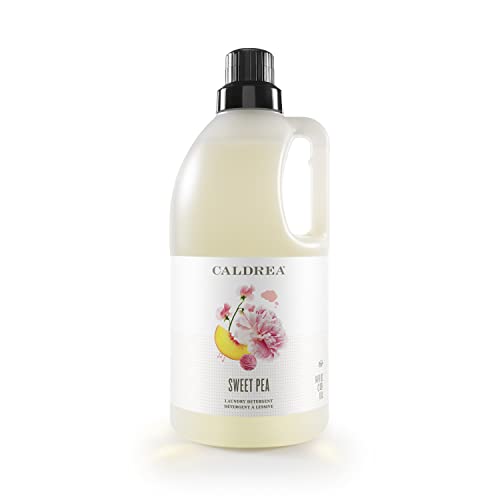

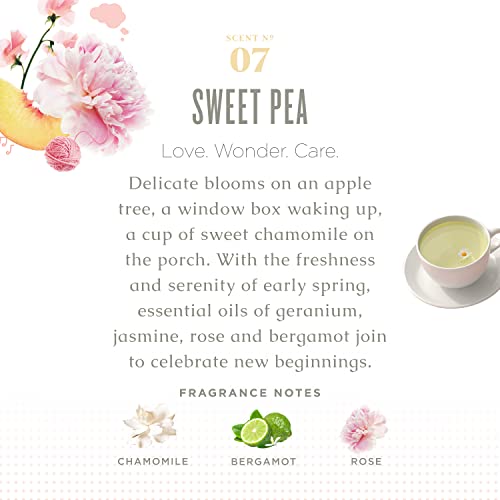
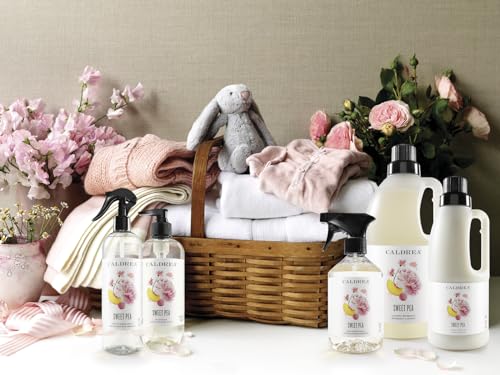
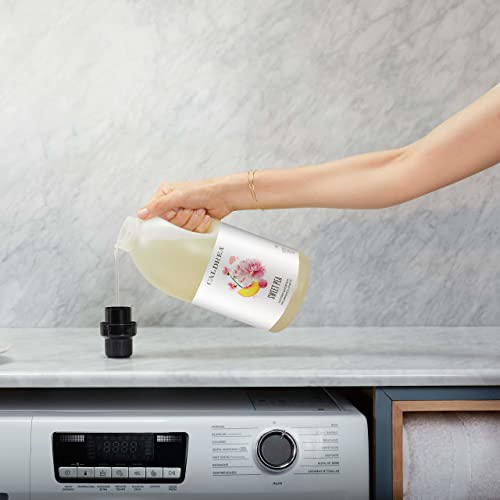
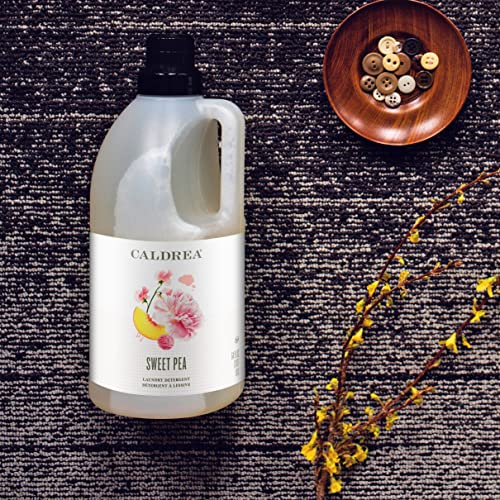
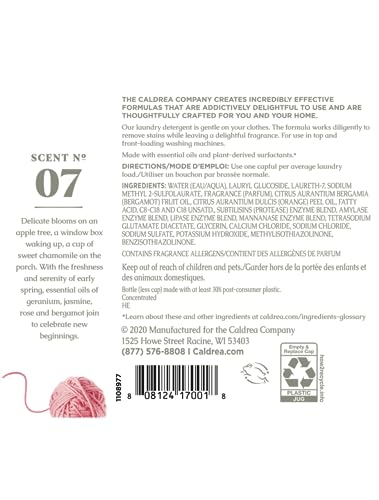
Caldrea Concentrated Laundry Detergent - Odor & Stain Removal, Biodegradable, Sweet Pea - 64oz


Jasminum Officinale (Jasmine) Oil
High RiskJasminum officinale (jasmine) oil is a volatile essential oil derived from the flowers of the jasmine plant. It is commonly used in cosmetics and personal care products for its fragrance and potential therapeutic properties.
Sustai Insights
Jasmine oil offers functional benefits such as providing a pleasant fragrance and potential skin-soothing properties. However, it has a high allergenic potential, posing risks of allergic reactions in sensitive individuals. While its carcinogenicity and developmental toxicity are low, regulatory bodies have placed some restrictions on its use due to these concerns. Overall, the risk level associated with jasmine oil is high, particularly in formulations where skin contact is frequent. Safe usage practices should be observed, and alternatives like synthetic fragrances could be considered.
Fragrance
High RiskFragrance refers to a mixture of aromatic compounds used in products to provide scent. It is commonly listed as 'fragrance' or 'parfum' on product labels and can serve various functions, including enhancing user experience and masking undesirable odors.
Sustai Insights
Fragrance offers functional benefits by improving product appeal; however, it poses significant health risks, notably a high likelihood of causing allergies and allergic contact dermatitis. Environmental risks include potential pollution and endocrine disruption, though its overall carcinogenicity is low. Regulatory bodies have noted concerns regarding its use, leading to a high-risk classification. Safe usage practices should be observed, and alternatives such as natural essential oils are recommended for those sensitive to synthetic fragrances.
Citrus Aurantium Dulcis (Orange) Peel Oil
Medium RiskCitrus aurantium dulcis (orange) peel oil is derived from the peel of oranges and is commonly used in cosmetic and personal care products for its fragrance and potential skin benefits. It is known for its aromatic properties and is often included in formulations aimed at enhancing scent profiles.
Sustai Insights
Citrus aurantium dulcis (orange) peel oil offers functional benefits such as providing a pleasant scent and potential antimicrobial properties. However, it poses a high allergy risk and may cause skin irritation in sensitive individuals. Environmental concerns include moderate persistence and potential to contribute to pollution. Regulatory warnings indicate restrictions on use in certain products. Overall, the risk level is assessed as medium, and users are advised to practice caution, particularly those with known allergies. Alternatives like sweet orange essential oil may provide similar benefits with potentially lower risks.
Subtilisin
Medium RiskSubtilisin is an enzyme obtained by fermentation of certain bacteria, primarily used in cleaning products and detergents for its ability to break down proteins and remove stains. It functions as a protease, facilitating effective cleaning by degrading protein-based stains on fabrics and surfaces.
Sustai Insights
Subtilisin offers functional benefits as an effective stain remover in cleaning products and is biodegradable, contributing to sustainability. However, it is associated with moderate allergenic potential and high non-reproductive organ system toxicity, alongside low risks of carcinogenicity and reproductive toxicity. Regulatory assessments do not list significant restrictions, but caution is advised due to possible irritant effects. Given these factors, the overall risk level is assessed as medium, with recommendations for responsible usage and consideration of safer alternatives.
Lipase
Medium RiskLipase is an enzyme that hydrolyzes triglycerides, facilitating the digestion and absorption of fats in the body. It plays a crucial role in lipid metabolism and is commonly used in various food and dietary products to enhance fat breakdown.
Sustai Insights
Lipase serves as an effective digestive aid, promoting fat metabolism and improving nutrient absorption. It is generally recognized as safe, with low concerns regarding carcinogenicity and developmental toxicity. However, there is a moderate risk of allergies and immunotoxicity. Environmental impacts are minimal, but regulatory bodies have placed some restrictions on specific uses. Overall, the risk level is assessed as medium, and users should follow safe usage recommendations. Alternatives such as other digestive enzymes may offer similar benefits.
Sodium Methyl 2 Sulfolaurate
Low RiskSodium methyl 2 sulfolaurate is a surfactant primarily used in personal care and cleaning products. It functions to reduce surface tension, enabling better spreading and cleaning properties. This ingredient is typically derived from renewable resources and is noted for its mild nature in formulations.
Sustai Insights
Sodium methyl 2 sulfolaurate offers functional benefits as an effective surfactant, contributing to the cleaning efficacy of products while being derived from renewable sources, which supports sustainability. Health risks are considered low, with no significant concerns regarding carcinogenicity, allergies, or reproductive toxicity. Environmental risks are also low, as it does not bioaccumulate or contribute significantly to pollution. Regulatory bodies do not impose restrictions on its use. Overall, this ingredient presents a low-risk profile, with no notable adverse effects, making it a viable option in formulations.
Laureth 7
Low RiskLaureth-7 is a polyethylene glycol-based surfactant commonly used in personal care products for its emulsifying and cleansing properties. It helps to stabilize formulations and improve texture, facilitating the mixture of oil and water. Additionally, it enhances the spreadability of products on the skin.
Sustai Insights
Laureth-7 serves as an effective emulsifier, contributing to product stability and texture enhancement. It is generally considered low risk concerning carcinogenicity, allergies, and reproductive toxicity. Environmental concerns are minimal, as it does not significantly contribute to pollution or bioaccumulation. Regulatory bodies impose few restrictions, affirming its safety profile. Safe usage practices include avoiding use in high concentrations, particularly in sensitive areas. Alternatives like plant-derived emulsifiers may be explored for sustainability. Overall, the ingredient presents a low-risk assessment.
Coconut Fatty Acid
Low RiskCoconut fatty acid is a mixture of fatty acids derived from coconut oil, primarily composed of caprylic and capric acids. It is commonly used in cosmetic formulations for its emollient properties, helping to moisturize and soften the skin.
Sustai Insights
Coconut fatty acid serves as an effective emollient, enhancing skin hydration and texture. It is considered to have low health risks, with minimal concerns regarding carcinogenicity, allergenic potential, and reproductive toxicity. Environmentally, it is not recognized as a pollutant or bioaccumulative. Regulatory bodies do not impose significant restrictions on its use. Overall, the ingredient poses low risk, and its safe application in cosmetic products is supported by its favorable profile.
Cocamidopropyl Hydroxysultaine
Low RiskCocamidopropyl hydroxysultaine is a synthetic skin and hair conditioning agent commonly used in personal care products. It functions primarily as a surfactant, providing foaming and emulsifying properties, while also contributing to the conditioning of hair and skin.
Sustai Insights
Cocamidopropyl hydroxysultaine offers functional benefits as a mild surfactant and conditioning agent, with low concerns regarding carcinogenicity, allergies, and reproductive toxicity. It is generally regarded as safe with low irritation potential. Environmental assessments indicate low pollutant potential and minimal bioaccumulation. Regulatory bodies have not imposed significant restrictions on its use, aligning with low risk levels overall. Safe usage is advised, particularly for sensitive populations, and alternative gentle surfactants may be considered for those seeking greener options. In conclusion, this ingredient is classified as low risk.
Amylase
Low RiskAmylase is an enzyme that catalyzes the breakdown of starches into sugars. It is commonly used in food processing, detergents, and other industrial applications to enhance product functionality. Its effectiveness depends on specific conditions, such as temperature and pH, making it versatile in applications ranging from baking to stain removal.
Sustai Insights
Amylase offers functional benefits by efficiently breaking down starches, enhancing food texture and cleaning performance. It is widely recognized as safe and biodegradable, aligning with sustainability goals. However, exposure may pose irritation risks for individuals with enzyme allergies, particularly through inhalation or skin contact. Regulatory assessments classify amylase as generally safe, with no carcinogenic or endocrine-disrupting properties reported. Environmental risks are minimal due to its natural degradability, and its use in products typically adheres to stringent safety standards. While alternative enzymes exist, amylase remains a preferred choice due to its efficiency and low overall risk, which is considered manageable with appropriate precautions.
Caprylyl/ Capryl Glycoside
Low RiskCaprylyl/Capryl Glycoside is a surfactant derived from natural sources, primarily used in personal care and cosmetic products for its emulsifying properties. It helps to stabilize formulations and enhance cleaning efficacy while being gentle on the skin.
Sustai Insights
Caprylyl/Capryl Glycoside offers functional benefits as a mild surfactant and emulsifier, contributing to product stability without significant irritation. It is biodegradable and considered sustainably sourced. Health risks are low, with minimal concerns regarding carcinogenicity and developmental toxicity. Environmental impact is also low, as it does not accumulate in ecosystems. Regulatory assessments indicate no current restrictions. Overall, it presents a low risk profile, making it a suitable choice in formulations.
Sodium Citrate
Low RiskSodium citrate is used in cosmetic formulations primarily as a buffering agent, helping to stabilize pH levels. It is derived from citric acid and is commonly found in various personal care products to enhance their efficacy and stability.
Sustai Insights
Sodium citrate offers functional benefits such as effective pH regulation and acts as a mild preservative. It is generally recognized as safe with low risks for cancer, allergies, and reproductive toxicity. Environmental concerns are minimal, with no significant pollutant potential or bioaccumulation. Regulatory bodies like the FDA and COSMOS have no major restrictions on its use. Overall, sodium citrate presents a low risk, making it a viable ingredient in cosmetic formulations. Safe usage practices should be followed, and alternatives are not typically necessary.
Tetrasodium Glutamate Diacetate
Low RiskTetrasodium glutamate diacetate is a sodium salt of glutamic acid, primarily functioning as a chelating agent in various cosmetic and personal care products. It helps stabilize formulations by binding metal ions, thereby enhancing product efficacy and shelf life.
Sustai Insights
Tetrasodium glutamate diacetate is recognized for its functional benefits in stabilizing formulations and preventing metal ion interference. It poses low health risks, with minimal concerns regarding carcinogenicity, allergies, or reproductive toxicity. Environmental impacts are also low, with no significant pollutant or bioaccumulation concerns noted. Regulatory bodies do not impose severe restrictions on its use. Overall, it is considered a low-risk ingredient. Safe usage practices should be followed, and alternatives such as other chelating agents may be explored for specific formulations.
Sea Salt
Low RiskSea salt is a mixture of inorganic salts derived primarily from the evaporation of seawater. It consists mainly of sodium chloride, with minor amounts of other minerals. Sea salt is commonly used as a seasoning and preservative in food products and may also have applications in cosmetics and personal care items.
Sustai Insights
Sea salt serves as an effective flavor enhancer and preservative, contributing to the taste and shelf-life of food products. It is generally considered safe with low risk for health concerns such as cancer, allergies, and reproductive toxicity. Environmental impact is minimal, as it does not contribute significantly to pollution or bioaccumulation. Regulatory bodies, including the FDA, currently do not impose restrictions on its use. Overall, the risk level associated with sea salt is low, making it a widely accepted ingredient with no significant adverse effects reported.
Citrus Aurantium Dulcis (Orange) Peel Oil
Medium RiskCitrus aurantium dulcis (orange) peel oil is derived from the peel of oranges and is commonly used in cosmetic and personal care products for its fragrance and potential skin benefits. It is known for its aromatic properties and is often included in formulations aimed at enhancing scent profiles.
Sustai Insights
Citrus aurantium dulcis (orange) peel oil offers functional benefits such as providing a pleasant scent and potential antimicrobial properties. However, it poses a high allergy risk and may cause skin irritation in sensitive individuals. Environmental concerns include moderate persistence and potential to contribute to pollution. Regulatory warnings indicate restrictions on use in certain products. Overall, the risk level is assessed as medium, and users are advised to practice caution, particularly those with known allergies. Alternatives like sweet orange essential oil may provide similar benefits with potentially lower risks.
Sodium Methyl 2 Sulfolaurate
Low RiskSodium methyl 2 sulfolaurate is a surfactant primarily used in personal care and cleaning products. It functions to reduce surface tension, enabling better spreading and cleaning properties. This ingredient is typically derived from renewable resources and is noted for its mild nature in formulations.
Sustai Insights
Sodium methyl 2 sulfolaurate offers functional benefits as an effective surfactant, contributing to the cleaning efficacy of products while being derived from renewable sources, which supports sustainability. Health risks are considered low, with no significant concerns regarding carcinogenicity, allergies, or reproductive toxicity. Environmental risks are also low, as it does not bioaccumulate or contribute significantly to pollution. Regulatory bodies do not impose restrictions on its use. Overall, this ingredient presents a low-risk profile, with no notable adverse effects, making it a viable option in formulations.
Laureth 7
Low RiskLaureth-7 is a polyethylene glycol-based surfactant commonly used in personal care products for its emulsifying and cleansing properties. It helps to stabilize formulations and improve texture, facilitating the mixture of oil and water. Additionally, it enhances the spreadability of products on the skin.
Sustai Insights
Laureth-7 serves as an effective emulsifier, contributing to product stability and texture enhancement. It is generally considered low risk concerning carcinogenicity, allergies, and reproductive toxicity. Environmental concerns are minimal, as it does not significantly contribute to pollution or bioaccumulation. Regulatory bodies impose few restrictions, affirming its safety profile. Safe usage practices include avoiding use in high concentrations, particularly in sensitive areas. Alternatives like plant-derived emulsifiers may be explored for sustainability. Overall, the ingredient presents a low-risk assessment.
Coconut Fatty Acid
Low RiskCoconut fatty acid is a mixture of fatty acids derived from coconut oil, primarily composed of caprylic and capric acids. It is commonly used in cosmetic formulations for its emollient properties, helping to moisturize and soften the skin.
Sustai Insights
Coconut fatty acid serves as an effective emollient, enhancing skin hydration and texture. It is considered to have low health risks, with minimal concerns regarding carcinogenicity, allergenic potential, and reproductive toxicity. Environmentally, it is not recognized as a pollutant or bioaccumulative. Regulatory bodies do not impose significant restrictions on its use. Overall, the ingredient poses low risk, and its safe application in cosmetic products is supported by its favorable profile.
Cocamidopropyl Hydroxysultaine
Low RiskCocamidopropyl hydroxysultaine is a synthetic skin and hair conditioning agent commonly used in personal care products. It functions primarily as a surfactant, providing foaming and emulsifying properties, while also contributing to the conditioning of hair and skin.
Sustai Insights
Cocamidopropyl hydroxysultaine offers functional benefits as a mild surfactant and conditioning agent, with low concerns regarding carcinogenicity, allergies, and reproductive toxicity. It is generally regarded as safe with low irritation potential. Environmental assessments indicate low pollutant potential and minimal bioaccumulation. Regulatory bodies have not imposed significant restrictions on its use, aligning with low risk levels overall. Safe usage is advised, particularly for sensitive populations, and alternative gentle surfactants may be considered for those seeking greener options. In conclusion, this ingredient is classified as low risk.
Amylase
Low RiskAmylase is an enzyme that catalyzes the breakdown of starches into sugars. It is commonly used in food processing, detergents, and other industrial applications to enhance product functionality. Its effectiveness depends on specific conditions, such as temperature and pH, making it versatile in applications ranging from baking to stain removal.
Sustai Insights
Amylase offers functional benefits by efficiently breaking down starches, enhancing food texture and cleaning performance. It is widely recognized as safe and biodegradable, aligning with sustainability goals. However, exposure may pose irritation risks for individuals with enzyme allergies, particularly through inhalation or skin contact. Regulatory assessments classify amylase as generally safe, with no carcinogenic or endocrine-disrupting properties reported. Environmental risks are minimal due to its natural degradability, and its use in products typically adheres to stringent safety standards. While alternative enzymes exist, amylase remains a preferred choice due to its efficiency and low overall risk, which is considered manageable with appropriate precautions.
Jasminum Officinale (Jasmine) Oil
High RiskJasminum officinale (jasmine) oil is a volatile essential oil derived from the flowers of the jasmine plant. It is commonly used in cosmetics and personal care products for its fragrance and potential therapeutic properties.
Sustai Insights
Jasmine oil offers functional benefits such as providing a pleasant fragrance and potential skin-soothing properties. However, it has a high allergenic potential, posing risks of allergic reactions in sensitive individuals. While its carcinogenicity and developmental toxicity are low, regulatory bodies have placed some restrictions on its use due to these concerns. Overall, the risk level associated with jasmine oil is high, particularly in formulations where skin contact is frequent. Safe usage practices should be observed, and alternatives like synthetic fragrances could be considered.
Caprylyl/ Capryl Glycoside
Low RiskCaprylyl/Capryl Glycoside is a surfactant derived from natural sources, primarily used in personal care and cosmetic products for its emulsifying properties. It helps to stabilize formulations and enhance cleaning efficacy while being gentle on the skin.
Sustai Insights
Caprylyl/Capryl Glycoside offers functional benefits as a mild surfactant and emulsifier, contributing to product stability without significant irritation. It is biodegradable and considered sustainably sourced. Health risks are low, with minimal concerns regarding carcinogenicity and developmental toxicity. Environmental impact is also low, as it does not accumulate in ecosystems. Regulatory assessments indicate no current restrictions. Overall, it presents a low risk profile, making it a suitable choice in formulations.
Subtilisin
Medium RiskSubtilisin is an enzyme obtained by fermentation of certain bacteria, primarily used in cleaning products and detergents for its ability to break down proteins and remove stains. It functions as a protease, facilitating effective cleaning by degrading protein-based stains on fabrics and surfaces.
Sustai Insights
Subtilisin offers functional benefits as an effective stain remover in cleaning products and is biodegradable, contributing to sustainability. However, it is associated with moderate allergenic potential and high non-reproductive organ system toxicity, alongside low risks of carcinogenicity and reproductive toxicity. Regulatory assessments do not list significant restrictions, but caution is advised due to possible irritant effects. Given these factors, the overall risk level is assessed as medium, with recommendations for responsible usage and consideration of safer alternatives.
Sodium Citrate
Low RiskSodium citrate is used in cosmetic formulations primarily as a buffering agent, helping to stabilize pH levels. It is derived from citric acid and is commonly found in various personal care products to enhance their efficacy and stability.
Sustai Insights
Sodium citrate offers functional benefits such as effective pH regulation and acts as a mild preservative. It is generally recognized as safe with low risks for cancer, allergies, and reproductive toxicity. Environmental concerns are minimal, with no significant pollutant potential or bioaccumulation. Regulatory bodies like the FDA and COSMOS have no major restrictions on its use. Overall, sodium citrate presents a low risk, making it a viable ingredient in cosmetic formulations. Safe usage practices should be followed, and alternatives are not typically necessary.
Tetrasodium Glutamate Diacetate
Low RiskTetrasodium glutamate diacetate is a sodium salt of glutamic acid, primarily functioning as a chelating agent in various cosmetic and personal care products. It helps stabilize formulations by binding metal ions, thereby enhancing product efficacy and shelf life.
Sustai Insights
Tetrasodium glutamate diacetate is recognized for its functional benefits in stabilizing formulations and preventing metal ion interference. It poses low health risks, with minimal concerns regarding carcinogenicity, allergies, or reproductive toxicity. Environmental impacts are also low, with no significant pollutant or bioaccumulation concerns noted. Regulatory bodies do not impose severe restrictions on its use. Overall, it is considered a low-risk ingredient. Safe usage practices should be followed, and alternatives such as other chelating agents may be explored for specific formulations.
Fragrance
High RiskFragrance refers to a mixture of aromatic compounds used in products to provide scent. It is commonly listed as 'fragrance' or 'parfum' on product labels and can serve various functions, including enhancing user experience and masking undesirable odors.
Sustai Insights
Fragrance offers functional benefits by improving product appeal; however, it poses significant health risks, notably a high likelihood of causing allergies and allergic contact dermatitis. Environmental risks include potential pollution and endocrine disruption, though its overall carcinogenicity is low. Regulatory bodies have noted concerns regarding its use, leading to a high-risk classification. Safe usage practices should be observed, and alternatives such as natural essential oils are recommended for those sensitive to synthetic fragrances.
Sea Salt
Low RiskSea salt is a mixture of inorganic salts derived primarily from the evaporation of seawater. It consists mainly of sodium chloride, with minor amounts of other minerals. Sea salt is commonly used as a seasoning and preservative in food products and may also have applications in cosmetics and personal care items.
Sustai Insights
Sea salt serves as an effective flavor enhancer and preservative, contributing to the taste and shelf-life of food products. It is generally considered safe with low risk for health concerns such as cancer, allergies, and reproductive toxicity. Environmental impact is minimal, as it does not contribute significantly to pollution or bioaccumulation. Regulatory bodies, including the FDA, currently do not impose restrictions on its use. Overall, the risk level associated with sea salt is low, making it a widely accepted ingredient with no significant adverse effects reported.
Lipase
Medium RiskLipase is an enzyme that hydrolyzes triglycerides, facilitating the digestion and absorption of fats in the body. It plays a crucial role in lipid metabolism and is commonly used in various food and dietary products to enhance fat breakdown.
Sustai Insights
Lipase serves as an effective digestive aid, promoting fat metabolism and improving nutrient absorption. It is generally recognized as safe, with low concerns regarding carcinogenicity and developmental toxicity. However, there is a moderate risk of allergies and immunotoxicity. Environmental impacts are minimal, but regulatory bodies have placed some restrictions on specific uses. Overall, the risk level is assessed as medium, and users should follow safe usage recommendations. Alternatives such as other digestive enzymes may offer similar benefits.
Transform laundry day into a delightful experience with Caldrea Liquid Laundry Detergent in Sweet Pea scent. Specially crafted with essential oils and plant-derived surfactants, this powerful yet gentle formula effectively removes odors and stains, ensuring your fabrics look vibrant and fresh.
- Versatile Cleaning: Safe for all fabrics and effective in any temperature, making it perfect for every load, from delicate silks to durable cottons.
- Eco-Friendly Formula: Made with biodegradable ingredients, free from phosphates and chlorine, promoting a healthier planet while keeping your clothes clean.
- Color Preservation: Powerful plant-based ingredients maintain whites and vivid colors, ensuring your wardrobe stays bright wash after wash.
- User-Friendly: Compatible with both top and front-loading machines, and easy to measure for hassle-free laundry days.
- Pleasant Scent: Infused with the charming aroma of Sweet Pea, your laundry will be left smelling fresh and inviting, turning chores into a joy.
Caldrea combines efficiency with sustainability, empowering you to make eco-conscious choices without sacrificing quality.
Subscribe & Save with Sustai
- Best Price Guarantee: Always enjoy the lowest prices on sustainable home essentials.
- No Surprises: We’ll notify you before shipping. No hidden fees, ever.
- You’re in Charge: Change, pause, or cancel your subscription anytime with ease.
- Eco-Friendly Deliveries: Our grouped shipments mean less packaging and lower emissions.
Join us on a sustainable journey. Special offers for a limited time! Prices and promotions may change.
Recommended Products
Transform laundry day into a delightful experience with Caldrea Liquid Laundry Detergent in Sweet Pea scent. Specially crafted with essential oils and plant-derived surfactants, this powerful yet gentle formula effectively removes odors and stains, ensuring your fabrics look vibrant and fresh.
- Versatile Cleaning: Safe for all fabrics and effective in any temperature, making it perfect for every load, from delicate silks to durable cottons.
- Eco-Friendly Formula: Made with biodegradable ingredients, free from phosphates and chlorine, promoting a healthier planet while keeping your clothes clean.
- Color Preservation: Powerful plant-based ingredients maintain whites and vivid colors, ensuring your wardrobe stays bright wash after wash.
- User-Friendly: Compatible with both top and front-loading machines, and easy to measure for hassle-free laundry days.
- Pleasant Scent: Infused with the charming aroma of Sweet Pea, your laundry will be left smelling fresh and inviting, turning chores into a joy.
Caldrea combines efficiency with sustainability, empowering you to make eco-conscious choices without sacrificing quality.

You can have at most 2 Sustainable Steals products in your cart
Customer Reviews
Customers’ View
Customers appreciate the cleaning power and delightful fragrance of Caldrea's Sweet Pea Laundry Detergent. Many reviews highlight its effectiveness in removing stains and odors while leaving fabrics fresh and vibrant. Users particularly value the eco-friendly formula made from biodegradable ingredients, making it a responsible choice for environmentally conscious households. While the longevity and durability of the product receive mixed feedback, with some expressing concerns about leakage and packaging quality, the overall sentiment reflects satisfaction with its natural ingredients and gentle performance on various fabrics. Overall, customers find this detergent aligns well with their health-conscious and sustainable lifestyles.
AI-generated from the text of customer reviewsThis product has no reviews yet.




